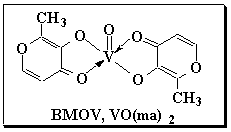
Speciation 98: Abstracts
Chris Orvig
Medicinal Inorganic Chemistry Group, Department of Chemistry and Faculty of Pharmaceutical Sciences, University of British Columbia, Vancouver, BC, Canada V6T 1Z1
A number of vanadium compounds have been reported to have insulin-mimetic properties, most notably when administered orally (a route via which insulin is not active).1 Still, gastrointestinal absorption (by passive diffusion) of vanadium is usually poor and depends on the chemical nature, solubility, and speciation of the metal ion complex. Little is known about the coordination properties of orally administered vanadium compounds in vivo, about the factors required to deliver vanadium to its ultimate site of action, or indeed where that site of action is.

The orally effective therapeutic agent bis(maltolato)oxovanadium(IV) (BMOV) is a potent insulin mimetic agent for the treatment of STZ-diabetic rats.2 BMOV and its analogs3 have considerable reaction chemistry which has direct relevance to insulin-mimesis; the preparations, redox chemistry, reaction chemistry and structures of several of these compounds will be presented, along with pertinent EPR, 51V NMR, potentiometric, and 48V biodistribution data. Particular attention will be paid to how speciation affects the choice of biological experiments for the elucidation of the mechanism of action.
References
